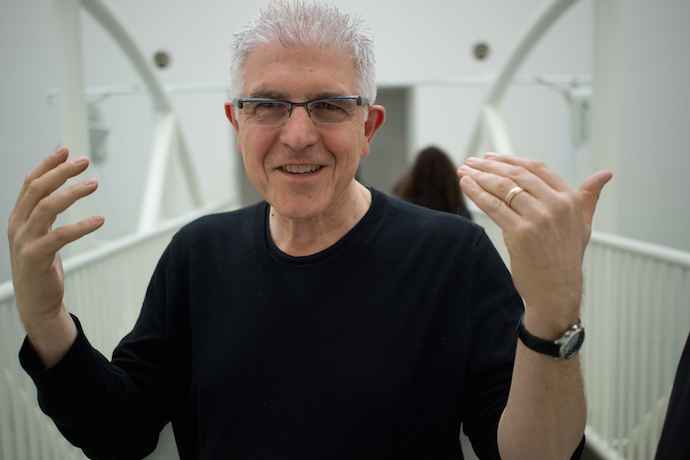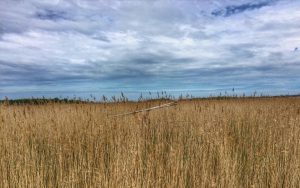
By Simon Fearn
After fifty years in sound art, acclaimed sound artist Bill Fontana is an expert in the field. He has reimagined the Millennium Bridge as a giant string instrument, recording the bridge’s vibrations and transposing the sound into the Tate Modern’s Turbine Hall. In 1994 he brought the natural white noise of the Normandy coast to the Arc de Triomphe to mark the 50th anniversary of the D Day Landings. His latest project finds Fontana unlocking the natural rhythms and industrial past of Suffolk arts complex Snape Maltings as part of the 2017 Aldeburgh Festival.
Studying at the Cleveland Institute of Music in the Sixties, Fontana found himself following a different path to the post-serialist consensus of the time. He describes the conceptual starting point of his career as the moment he realised that ‘active listening was a way of making music.’ ‘When I composed music I would get into a hyper-focused state of mind,’ Fontana says. ‘I found that my perception of ambient sounds became really acute and I became more interested in my perception of that sound than the music I was trying to write. I started recording sound whenever I felt that way, much the same as how a visual artist might use a camera.’
After studying under John Cage (‘he took me seriously at a time I needed to be taken seriously’) and taking inspiration from Marcel Duchamp’s Readymades (‘Duchamp really blew my mind with his idea of found objects as art’), Fontana set out to make ‘musical found objects’ with his sound sculptures. His aim, and for him the purpose of all art, is ‘to connect people to the present. To surprise someone, trigger someone’s imagination and awaken some new curiosity in what might seem like a very familiar landscape.’ His sound sculptures, which place familiar sounds in unfamiliar contexts and combinations and use vibration sensors to unveil ‘a kind of sonic secret in the landscape,’ awaken the audience to the sounds around them and deconstruct the arbitrary distinction between ‘noise’ and music.
I feel like in my brain there’s a kind of soundtrack running so that when I hear something new it connects me to something I heard somewhere before, like my memories are jamming with the sounds I’ve recorded.
Fontana’s latest project Acoustic Visions, which premiers as part of the Aldeburgh Festival, consists of three separate installations. The site-specific Sonic Dreamscapes and video installation Acoustic Vision of the River Alde Marshes both take the reedbeds of Snape Maltings as their inspiration. For Fontana, this was perhaps the most exciting thing about the project. ‘I’ve never worked with a landscape which has this kind of vegetation,’ says Fontana. ‘I spent many days gazing at the movements of these reedbeds. I experimented with recording them in different ways with normal acoustic microphones, but I found that the sound from the accelerometers [vibration sensors] was the most interesting. It’s the real sound inside the plants and it has a kind of purity and strangeness to it. It’s a kind of sound I don’t think anyone’s ever heard before.’
The third installation, Sonic Timelapse, explores the area’s industrial past in the archways of the derelict buildings. Fontana has created ‘a sound collage based on recordings of all kinds of industrial and farm machinery. It has a very percussive quality to it because in my studio I treated it in a way that’s pretty unusual. I don’t want to go into the details of it because I don’t want to give away my family secrets!’

Reed Beds at Snape Maltings, the site of Fontana’s installation
Fontana’s vast and varied experiences exploring the sonic potential of different environments means he can be ‘very intuitive’ when approaching new projects. ‘Personally I feel I’ve got the ability to find something interesting in any sound I choose to listen to and I really like doing that,’ he says. ‘I feel like in my brain there’s a kind of soundtrack running so that when I hear something new it connects me to something I heard somewhere before, like my memories are jamming with the sounds I’ve recorded.’
Things couldn’t be more different than when Fontana embarked on his long career, with sound art now a regular part of many music programmes and people slowly becoming more receptive to everyday soundscapes. He points to the success of Susan Philipsz in particular, the first artist exclusively working with sound to be nominated for and win the Turner Prize. Her work, which has so far included broadcasting a 16th Century Sottish lament beneath Glasgow’s George V Bridge and a sound sculpture featuring war-damaged instruments, while very different to Fontana’s oeuvre, is further proof that the illusory boundaries between ‘noise’, music and art are gradually breaking down.
At this stage in Fontana’s career he can either look back at the many achievements of the past or ‘think of things that I haven’t done and want to do.’ These include (fantastically) putting vibration sensors on the moon and recording the Doppler shift when travelling at the speed of light. More prosaically, he has a continued ambition to record the vibrations of the silent bells of Big Ben and is putting the finishing touches on his largest video installation to date in Lisbon. Acoustic Visions is further proof of Fontana’s ability to engage with landscapes, probing their ‘sonic secrets’ and unlocking new listening experiences.
Bill Fontana: Acoustic Visions is on at Snape Maltings, during the Aldeburgh Festival 9-25 June 2017 (10am-9pm) as part of the 50th anniversary celebrations of the Snape Maltings Concert Hall. ![]()